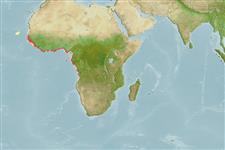>
Pleuronectiformes (Flatfishes) >
Cyclopsettidae (Sand whiffs)
Etymology: Citharichthys: Latin, cithara = lire like instrument + Greek, ichthys = fish (Ref. 45335).
Eponymy: Franz Xaver Stampfli (1847–1903) was a German (possibly Swiss) naturalist who was working in Liberia (1879–1887). [...] (Ref. 128868), visit book page.
More on author: Steindachner.
Environment: milieu / climate zone / depth range / distribution range
Ecología
marino; agua dulce; salobre demersal; rango de profundidad 0 - 50 m (Ref. 2683). Tropical; 21°N - 18°S, 26°W - 20°E
Eastern Atlantic: Senegal to Angola (Ref. 5979, 81290, 81683). Also reported from Mauritania (Ref. 55783).
Tamaño / Peso / Age
Maturity: Lm ? range ? - ? cm
Max length : 17.6 cm TL macho / no sexado; (Ref. 128374); peso máximo publicado: 73.00 g (Ref. 126037)
Short description
Claves de identificación | Morfología | Morfometría
Espinas dorsales (total) : 0; Radios blandos dorsales (total) : 80 - 87; Espinas anales: 0; Radios blandos anales: 59 - 65. Diagnosis: body oval, its depth 45-50% SL (Ref. 81290, 81683). Head length 27-31% SL; eye diameter 16-23% HL; teeth in a single row on upper as well as lower jaw, no caniniform teeth (Ref. 81683). Interorbital space narrow and slightly concave (Ref. 81290, 81683). Hind end of maxilla extending to below centre of eye (Ref. 81290, 81683) but never posterior to posterior edge of pupil (Ref. 81683). Fin base length of both pelvic fins short and of about equal length (Ref. 81683). Body covered with cycloid or weakly ctenoid scales (Ref. 81290, 81683). Gill rakers moderately long and slender (Ref. 81290, 81683), about 2/3-3/4 length of gill filaments at angle of gill arch (Ref. 81683).
Coloration: eyed side yellowish brown with dark spots along dorsal and anal fins; dark brown spot at base of caudal fin, as well as on upper and lower caudal fin rays; dorsal and anal fins with a series of dark brown spots; blind side entirely whitish (Ref. 81620, 81683).
Occurs in coastal waters (Ref. 2683, 81290) and brackish water of estuaries and lagoons (Ref. 81290, 81683), also ascending rivers (Ref. 81683) and entering freshwater (Ref. 2683). Feeds on fish, shrimps and crabs (Ref. 28587).
Life cycle and mating behavior
Madurez | Reproducción | Puesta | Huevos | Fecundidad | Larva
Distinct pairing (Ref. 205). Oviparous (Ref. 101737). Females produce numerous eggs in multiple spawnings during a prolonged spawning period (Ref. 101737).
Aldebert, Y., M. Desoutter and J.-C. Quéro, 1990. Bothidae. p. 1027-1036. In J.C. Quero, J.C. Hureau, C. Karrer, A. Post and L. Saldanha (eds.) Check-list of the fishes of the eastern tropical Atlantic (CLOFETA). JNICT, Lisbon; SEI, Paris; and UNESCO, Paris. Vol. 2. (Ref. 5979)
IUCN Red List Status (Ref. 130435: Version 2024-2)
Threat to humans
Harmless
Human uses
Pesquerías: comercial
Herramientas
Special reports
Download XML
Fuentes de Internet
Estimates based on models
Preferred temperature (Ref.
123201): 23.7 - 28, mean 26.7 °C (based on 66 cells).
Phylogenetic diversity index (Ref.
82804): PD
50 = 0.5000 [Uniqueness, from 0.5 = low to 2.0 = high].
Bayesian length-weight: a=0.00490 (0.00320 - 0.00749), b=3.28 (3.16 - 3.40), in cm total length, based on LWR estimates for this species & Genus-body shape (Ref.
93245).
Nivel trófico (Ref.
69278): 3.9 ±0.55 se; based on food items.
Resiliencia (Ref.
120179): Alto, población duplicada en un tiempo mínimo inferior a 15 meses (Preliminary K or Fecundity.).
Fishing Vulnerability (Ref.
59153): Low vulnerability (10 of 100).
Nutrients (Ref.
124155): Calcium = 279 [133, 549] mg/100g; Iron = 1.31 [0.64, 2.52] mg/100g; Protein = 17.1 [15.0, 19.1] %; Omega3 = 0.167 [0.079, 0.343] g/100g; Selenium = 48.1 [21.8, 105.2] μg/100g; VitaminA = 15.6 [4.7, 57.4] μg/100g; Zinc = 1.36 [0.89, 2.02] mg/100g (wet weight);
